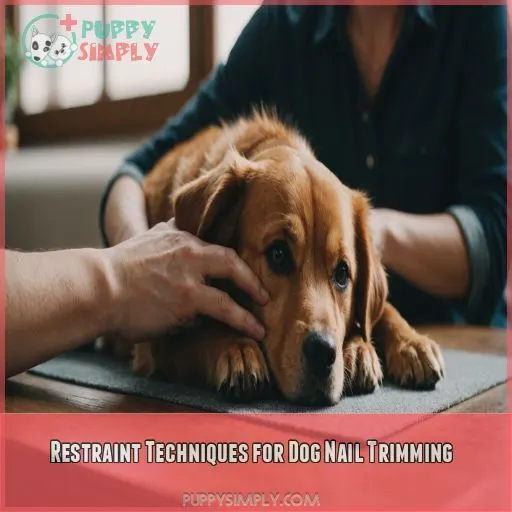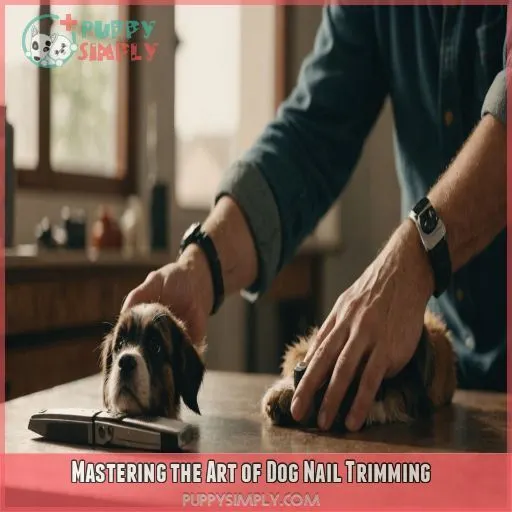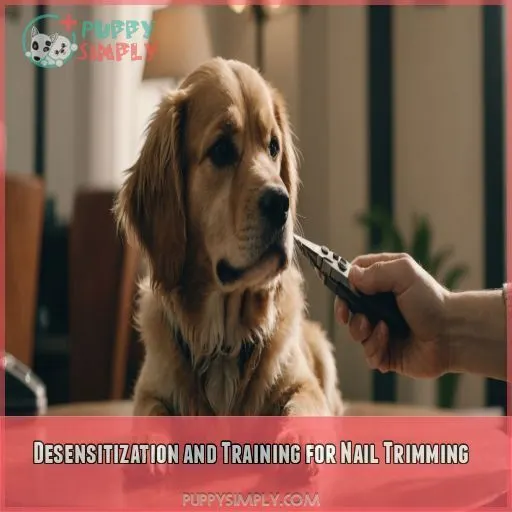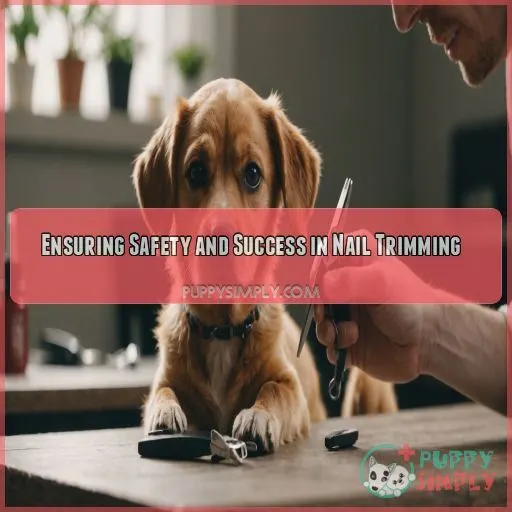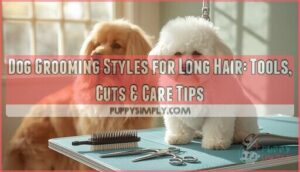This site is supported by our readers. We may earn a commission, at no cost to you, if you purchase through links.
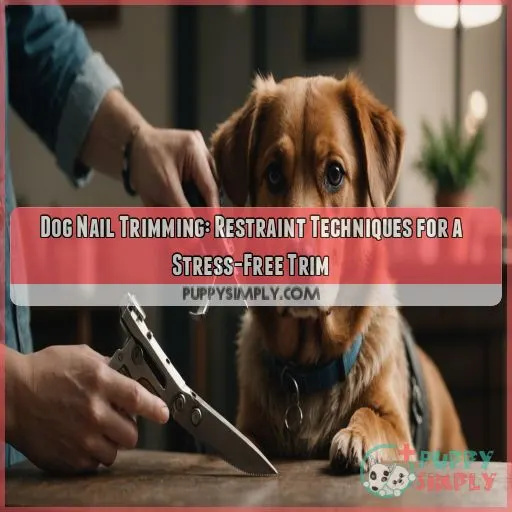
You want to master this delicate art to keep your furry friend safe and comfortable.
Start by choosing the right restraint technique: drape and lean, side position, or firm grip.
Minimize stress and fear with positive reinforcement, gentle touch, and a calm demeanor.
As you get the hang of it, you’ll find the perfect balance between control and care.
But, be warned: it’s not just about the technique – your dog’s emotional state plays a big role.
And that’s where things get really interesting.
Table Of Contents
- Key Takeaways
- Restraint Techniques for Dog Nail Trimming
- Mastering the Art of Dog Nail Trimming
- Desensitization and Training for Nail Trimming
- Common Challenges in Dog Nail Trimming
- Ensuring Safety and Success in Nail Trimming
- Frequently Asked Questions (FAQs)
- How to restrain a dog when clipping nails?
- How to cut your dog’s nails when they won’t let you?
- How do you hold clippers when cutting a dog’s nails?
- How to restrain a dog while grooming?
- How often should I trim my dogs nails at home?
- What are the benefits of using nail grinders over clippers?
- Can I trim my dogs nails when they are pregnant?
- How do I trim the nails of a senior dog?
- What are the signs of nail trimming anxiety in dogs?
- Conclusion
Key Takeaways
- You’ll need to choose the right restraint technique for your furry friend—whether it’s the "drape and lean," side position, or firm grip—to keep them calm and secure throughout the process. Remember, it’s not just about the technique; your dog’s emotional state plays a big role too.
- To minimize stress and fear, create a safe environment, use Positive Reinforcement like treats and praise, and gradually expose your dog to restraint and nail handling. Your calm demeanor will also help ease their anxiety—so take a deep breath and relax.
- When it comes to the actual trimming, focus on the angle and pressure, and make sure to avoid the quick (the pink part of the nail that contains nerves and blood vessels). If you do accidentally cut the quick, have styptic powder on hand to stop the bleeding.
- Desensitization and training are key to making nail trimming a breeze for both you and your dog. Gradually get your dog comfortable with having their paws handled, introduce the trimming tools, and reward calm behavior—with patience and consistency, you’ll be trimming like a pro in no time.
Restraint Techniques for Dog Nail Trimming
You’re about to tackle one of the most intimidating tasks in dog grooming: nail trimming. To set yourself up for success, mastering the art of restraint techniques that will keep your furry friend calm and secure throughout the process is vital.
Drape and Lean Method for Restraint
For dog nail trimming, the right restraint technique can make all the difference. Try the "Drape and Lean" method:
- 1. Stand beside your dog with your body close to theirs.
- 2. Drape your arms over their shoulders to prevent movement.
- 3. Lean your upper body over them to maintain control.
- 4. Reward calm behavior to build trust and confidence.
Side Position for Easier Control
If your furry friend is a wiggly pup, the drape and lean method mightn’t be enough. That’s when the side position comes in handy! Gently lay your dog on their side, making sure they’re comfortable and secure. This position allows for easier control, reducing the risk of accidental nips or scratches during nail trimming.
Firm Grip for Secure Hold
You’ve got your dog in position, now it’s time for a firm grip. Hold each toe securely with your thumb and forefinger, making sure not to squeeze too hard. A secure hold is key to safe nail trimming. Here are some tips to keep in mind:
- Hold the paw firmly but gently
- Support the joints to avoid straining
- Keep your hands in a comfortable position
- Use your body to help restrain the dog
- Be mindful of your dog’s body language cues.
Tips for Minimizing Stress and Fear
Minimizing stress and fear is important for a stress-free trim. Start by creating a safe environment – choose a quiet spot with minimal distractions. Use positive reinforcement like treats and praise to calm your dog. Gradually expose them to restraint, beginning with gentle touch and progressing to nail handling. Your calm demeanor will also help ease their anxiety.
Mastering the Art of Dog Nail Trimming
Now that you’ve got your dog comfortably restrained, it’s time to master the art of nail trimming – a key step that requires the right tools, technique, and a gentle touch. By choosing the right trimmer and learning the proper angle and pressure, you’ll be well on your way to giving your furry friend a stress-free trim.
Choosing the Right Trimmer for the Job
Now that you’ve got your pup comfortably restrained, it’s time to choose the right trimmer for the job! You’ll need to decide between guillotine and scissors-style clippers. Consider your dog’s nail size and type, as well as the trimmer’s material and blade sharpness. Don’t forget to check the trimmer’s maintenance requirements to keep them in top condition.
Angle and Pressure for Safe Trimming
Now that you’ve got the right trimmer, it’s time to master the technique! To trim safely, focus on the angle and pressure. Here are some tips:
- Hold the clipper so it’s perpendicular to the nail
- Apply gentle pressure, don’t squeeze too hard
- Cut from underneath, following the natural curve of the nail
- Keep your fingers away from the clipper blades
Avoiding the Quick to Prevent Bleeding
When trimming your dog’s nails, it’s important to avoid the quick – the pink part of the nail that contains nerves and blood vessels. Cutting it can cause bleeding, making the experience traumatic for both you and your dog.
| Nail Trimming Tips | Quick Identification |
|---|---|
| Use a nail trimmer with a safety stop | Look for a slight curve or a pinkish tint |
| Trim a little at a time, taking breaks | The quick grows with the nail, so adjust your trim accordingly |
| Reward your dog for staying calm | Trimming regularly helps you identify the quick more easily |
Trimming Dew Claws With Scissors-Type Trimmers
You’re tackling the tricky task of trimming dew claws. Grab your scissors-type trimmer and get comfortable.
Identify the quick, the pink part of the claw, and snip carefully to avoid it. This is a crucial step to prevent causing pain or bleeding to your pup.
For curved claws, use the curve of the scissor blade to follow the claw’s shape. This will help you trim the claw safely and effectively.
Keep styptic powder handy in case of accidents. This will help stop any bleeding if you accidentally cut the quick.
Reward your pup with treats for staying calm. This positive reinforcement will help make the experience less stressful for both you and your dog.
Desensitization and Training for Nail Trimming
You’re probably dreading nail trimming day, but with some prep work, you can make it a breeze for both you and your furry friend. By gradually getting your dog comfortable with having their paws handled and introducing the trimming tools, you’ll be well on your way to stress-free nail trims.
Handling Paws and Toes for Desensitization
In the matter of nail trimming, getting your dog comfortable with paw handling is key. To desensitize your dog, try these gentle techniques:
- Massage their paws and toes to help them relax
- Get them used to having their toes manipulated by gently wiggling each one
- Use a soft touch to hold each paw, making it a calming experience.
Introducing Tools Gradually for Stress Reduction
Now that your dog is comfortable with paw handling, it’s time to introduce the tools. Start with fake tools, like a pencil with an eraser, to simulate nail clipping. Gradually introduce real clippers, beginning with gentle touch and slight exposure. Reward calm behavior and consult a dog training professional if needed to address confusion by using positive reinforcement.
. A nail grinder can also aid in desensitization.
Positive Reinforcement for Calm Behavior
You’re making great progress with desensitization and training for nail trimming. Now, it’s time to focus on positive reinforcement for calm behavior. Reward your dog with treats, praise, and affection when they remain calm during nail handling. This gentle touch training helps reduce canine stress and creates a positive association with nail trimming, making future sessions a breeze.
Gradually Increasing Frequency and Duration
You’re making great strides in desensitizing your dog to nail trimming! Now, it’s time to step up the frequency and duration. Start by adding a few seconds to each session, gradually increasing the time over several weeks. As your dog becomes more comfortable, you can also trim more nails in one go, building trust and momentum.
Common Challenges in Dog Nail Trimming
You’re not alone if you’re struggling to trim your dog’s nails – many pet owners face common challenges that make this essential grooming task a tough experience. From sensitive nails and painful experiences to wriggling dogs and uncomfortable restraint, From sensitive nails and painful experiences, including risks of overgrown nails, to wriggling dogs and uncomfortable restraint, we’ll explore the most common hurdles and provide practical solutions to help you trim your dog’s nails with confidence and care.
.
Dealing With Sensitive Nails and Painful Experiences
When dealing with sensitive nails and painful experiences, you’re not alone! Many dogs (and owners) dread nail trimming due to past hurts. To avoid this, consider:
- Selecting the right clipper: Choose a clipper that’s designed for your dog’s nail type to minimize pressure.
- Desensitizing your dog: Gradually introduce nail handling and trimming to reduce stress.
- Rewarding calm behavior: Positive reinforcement can work wonders in making nail trimming a breeze.
Managing Stress and Fear in Dogs
Navigating the often-treacherous waters of dog nail clippers can be stressful for both you and your pup.
.
Managing your pup’s stress and fear is really important.
Recognize calming signals, such as yawning or avoidance, and respond with gentle, fear-free handling.
Reward calm behavior with treats and praise, leveraging positive reinforcement to ease anxiety.
Identify and sidestep stress triggers to create a more relaxed experience for both you and your furry friend.
Overcoming Uncomfortable Restraint and Handling
As you work to overcome uncomfortable restraint and handling, remember that building trust is key. Pay attention to your dog’s body language and calm signals, rewarding them with treats and praise for remaining calm. Use positive reinforcement and distraction techniques to make nail trimming a positive experience. With patience and consistency, your dog will learn to trust the process.
Solutions for Dogs That Won’t Stay Still
The eternal struggle: trying to trim your dog’s nails when they just won’t stay still! Don’t worry, friend, we’ve got some solutions for you. Try distraction techniques like treats or toys, or use calming aids like pheromone diffusers. Positive reinforcement and gentle restraint can also work wonders. If all else fails, consider seeking professional help for a stress-free trim.
Ensuring Safety and Success in Nail Trimming
As you get ready to trim your dog’s nails, you need to prioritize safety and success to avoid turning this necessary task into a stressful ordeal for both you and your furry friend. By taking the right precautions and knowing when to seek professional help, you can keep those nails healthy and your dog happy.
Safety Precautions for Trimming at Home
As you prepare for a stress-free trim, don’t forget to suit up for safety! Choose a quiet, distraction-free area and lay down a non-slip mat to prevent accidents. Sanitize your nail clippers and have a pet first aid kit nearby, just in case. Keep your furry friend calm and secure, and you’ll be trimming like a pro in no time!
Knowing When to Seek Professional Help
Don’t be a hero – know when to seek professional help with dog nail trimming. If you’re unsure or uncomfortable trimming your dog’s nails, or if they’ve specific health needs, consult a veterinarian or professional groomer. They can provide personalized guidance and help you identify potential nail problems before they become major issues.
Tips for Clipping Black Nails and Curved Claws
Clipping black nails and curved claws requires finesse. Here are some tips to help you master the technique:
- Use a good light source to improve black nail visibility
- Adjust your trimming angle for curved claws
- Trim a little at a time to avoid cutting the quick
- Study your dog’s nail growth patterns to anticipate challenges
- Practice makes perfect – be patient and gentle!
Maintaining a Regular Trimming Schedule for Healthy Nails
Now that you’ve mastered clipping those tricky black nails and curved claws, it’s time to talk maintenance. Your dog’s nail growth rate will dictate the frequency of trims. A good rule of thumb is to trim every 4-6 weeks, or when you notice signs of overgrowth. Regular trims prevent painful overgrowth and keep those paws healthy and happy!
Frequently Asked Questions (FAQs)
How to restrain a dog when clipping nails?
Imagine yourself as a gentle giant, wrapping your arms around your furry friend like a cozy blanket. To restrain your dog, drape your arms over them, leaning your upper body over their shoulders to prevent movement.
How to cut your dog’s nails when they won’t let you?
You’re struggling to cut your dog’s nails because they just won’t let you! Don’t worry, it’s not uncommon. Start by getting them used to having their paws handled, then gradually introduce the nail clippers (Source).
How do you hold clippers when cutting a dog’s nails?
Hold the clippers at a 45-degree angle, with the tip of the nail snugly in place, and squeeze the handle to cut from underneath – it’s like a mini haircut for your pup’s paws.
How to restrain a dog while grooming?
You’ve got a wiggly pup on your hands! To restrain them while grooming, try the "drape and lean" method: drape your arms over them and lean your upper body over their shoulders to prevent movement.
How often should I trim my dogs nails at home?
Trim your dog’s nails at home every 4-6 weeks, or as needed, depending on their lifestyle and nail growth. Keep an eye on those nails and trim them before they get too long to prevent discomfort and health issues in Frenchies.
.
What are the benefits of using nail grinders over clippers?
Oh, the bliss of nail grinders! You’ll be the nail ninja, slicing through the stress of clippers with ease. With grinders, you get smoother edges, less risk of cutting the quick, and a safer, more controlled experience – win-win!
Can I trim my dogs nails when they are pregnant?
How do I trim the nails of a senior dog?
Trimming a senior dog‘s nails is like giving them a spa day – gentle and relaxing. Use calm, patient movements, and consider a veterinarian’s guidance for the best approach, as older dogs may have sensitive paws and health concerns.
What are the signs of nail trimming anxiety in dogs?
Notice if your dog tenses up, pants, or tries to escape during nail trimming – these are signs of anxiety. Also, watch for yawning, licking, or avoiding eye contact, which can indicate they’re feeling uneasy or stressed.
Conclusion
As you master the delicate dance of dog nail anatomy with restraint, you’ll find that trust, patience, and gentle firmness become your best friends.
, you’ll find that trust, patience, and gentle firmness become your best friends.
With the right techniques, positive reinforcement, and a calm demeanor, you can transform a potentially stressful experience into a breeze.

